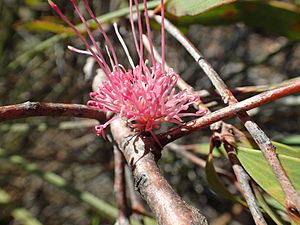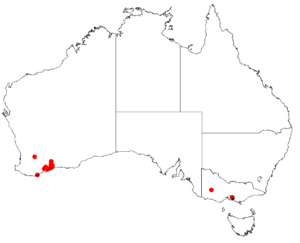Hakea obtusa facts for kids
Quick facts for kids Hakea obtusa |
|
|---|---|
 |
|
| Hakea obtusa in the Fitzgerald River National Park | |
| Scientific classification | |
| Genus: |
Hakea
|
| Species: |
obtusa
|
 |
|
| Occurrence data from AVH | |
The Hakea obtusa is a special kind of shrub that belongs to the plant family called Proteaceae. It's found only in a specific part of Western Australia, along the southern coast in the Goldfields-Esperance region. This means it is endemic to that area, growing naturally nowhere else in the world. This plant is known for its lovely white and pink flowers that smell sweet and bloom in autumn and spring.
Contents
What Does Hakea obtusa Look Like?
The Hakea obtusa is an open, rounded, and sturdy shrub. It usually grows to be about 1.5 to 3 meters (5 to 10 feet) tall. Unlike some other plants, it does not have a special woody base called a lignotuber that helps it regrow after a fire.
Flowers and Scent
This shrub blooms a lot from May to September. Its flowers are white and pink, and they have a wonderful sweet smell. Each flower has long, creamy-white parts called styles. These flowers grow directly on the bare branches of the plant.
Leaves and Fruit
The leaves of Hakea obtusa are shaped like long ovals, about 3 to 10 centimeters (1 to 4 inches) long and 1 to 2 centimeters (0.4 to 0.8 inches) wide. They have three clear lines running along them and end in a blunt, rounded tip. After the flowers, the plant produces rough, egg-shaped fruits. These fruits have a short, sharp point at the end.
Where Does Hakea obtusa Grow?
Hakea obtusa is only found in two main places in Western Australia: near Ravensthorpe and within the Fitzgerald River National Park. It likes to grow in areas with shrubs and low woodlands. You can find it in soils that are a mix of clay and loam, or in gravelly and ironstone soils.
Growing Conditions
This plant can handle frost, which means it can survive cold temperatures. It needs soil that drains water well, so it doesn't get too wet. It also likes to grow in a sunny spot.
How Was Hakea obtusa Named?
The Hakea obtusa was first officially described by a scientist named Carl Meisner in 1856. Its name comes from the Latin word obtusus, which means "blunt." This refers to the blunt, rounded shape of the plant's leaves.
Conservation Status
The good news is that the Western Australian Government has classified Hakea obtusa as "not threatened." This means that for now, there are enough of these plants, and they are not in danger of disappearing.
Images for kids


